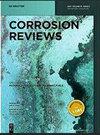Surface preparation and double layer effect for silane application on electrogalvanized steel
IF 3.2
4区 材料科学
Q3 ELECTROCHEMISTRY
引用次数: 0
Abstract
Abstract Silanes are an alternative to replace pretreatments based on Cr(VI) for electrogalvanized steel (ES). As the interaction between the silane and the metal is important to ensure pretreatment efficiency, surface preparation is a critical step. In this sense, the presence of OH groups on the metal surface is essential. In this paper, the surface preparation of ES and a single/double layer application on the corrosion protection afforded by 3-aminopropyltriethoxy silane was studied. The metal surface was cleaned by polishing, electrochemically (employing anodic or cathodic current) or by chemical oxidation. The electrochemical behavior of the cleaned surfaces was analyzed by cyclic voltammetry and electrochemical impedance spectroscopy (EIS). Afterwards, the hydrolyzed silane was applied in a single or double layer. Coatings were characterized by scanning electron microscopy and energy dispersive X-ray spectroscopy, EIS and by exposure to the humidity chamber. Coatings applied on ES cleaned by electrochemical anodic processes or chemical oxidation provided the best protective performance due to a lower surface of zinc exposed to the high humidity environment. Double layer coatings improved protection due to more homogeneous and higher Si content, sealing defects and increasing the thickness of the one-layer protection, enhancing the barrier protection of the silane.电镀锌钢上硅烷应用的表面制备及双层效应
摘要硅烷是一种替代基于Cr(VI)的电镀锌钢预处理的方法。由于硅烷和金属之间的相互作用对确保预处理效率很重要,因此表面制备是关键步骤。从这个意义上说,金属表面上OH基团的存在是必不可少的。本文研究了ES的表面制备及其在3-氨基丙基三乙氧基硅烷防腐中的单层/双层应用。通过抛光、电化学(采用阳极或阴极电流)或化学氧化来清洁金属表面。通过循环伏安法和电化学阻抗谱(EIS)分析了清洁表面的电化学行为。然后,以单层或双层的形式施加水解的硅烷。通过扫描电子显微镜、能量色散X射线光谱、EIS和暴露于湿度室对涂层进行了表征。由于暴露在高湿度环境中的锌的下表面,在通过电化学阳极工艺或化学氧化清洁的ES上涂覆的涂层提供了最佳的保护性能。双层涂层由于硅含量更均匀、更高、密封缺陷和增加了单层保护的厚度而提高了保护效果,增强了硅烷的阻隔保护。
本文章由计算机程序翻译,如有差异,请以英文原文为准。
求助全文
约1分钟内获得全文
求助全文
来源期刊

Corrosion Reviews
工程技术-材料科学:膜
CiteScore
5.20
自引率
3.10%
发文量
44
审稿时长
4.5 months
期刊介绍:
Corrosion Reviews is an international bimonthly journal devoted to critical reviews and, to a lesser extent, outstanding original articles that are key to advancing the understanding and application of corrosion science and engineering in the service of society. Papers may be of a theoretical, experimental or practical nature, provided that they make a significant contribution to knowledge in the field.
 求助内容:
求助内容: 应助结果提醒方式:
应助结果提醒方式:


